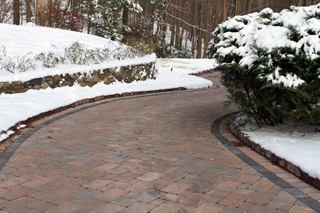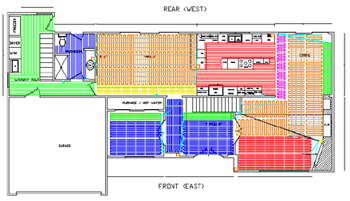If you’ve decided to add a heated driveway or underfloor heating system to your list of home improvement projects, hydronic heat might be the popular choice, but it’s not necessarily the best, or least expensive way to go. Electric radiant heat is a new, equally viable option that may give you some pause when it comes time to fork over that cash you’ve been stashing for your home improvement projects.
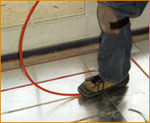
Let’s say you are considering adding radiant heat to your bathroom-remodeling project. In a small space, typical heating times can make all the difference, right down to the floorboards. A hydronic heated floor system installation requires PEX tubing placed 1½-2 inches into a cement slab for optimal results. At this depth, you could be waiting a few hours for things to heat up. To avoid the inconvenience of those long wait times, most homeowners tend to leave their hydronic heat systems on throughout the winter months, consuming more energy. An electric radiant heated floor can reduce that wait time by as much as 6½ hours. Radiant heating mats can be easily rolled out above the sub-floor, just under the flooring material, and can heat a tile floor in 30 to 60 minutes flat. With more reasonable wait times, programming the system to turn on and off potentially saves you more dollars, and frankly, makes more sense.
Installation costs tend to be higher for hydronic heating systems. Returning to our bathroom project, the $300 to $400 you would expect to spend installing a radiant heated floor will cost you upwards of $4,000 to $5,000. The upfront investment for equipment, labor and floor height issues make hydronic systems cost prohibitive in small- to medium-sized areas. Hydronic systems require a boiler, which accounts for a big chunk of the budget. Unlike radiant heated floor mats, hydronic floor heating systems also elevate the floor by a couple of inches, a significant difference that can cause big problems for you during your bathroom remodeling job. Radiant heated flooring installed will elevate the floor by only ⅛ of an inch. In this scenario, at least, it probably would not make much sense to run a series of tubing for a hydronic system in your bathroom.
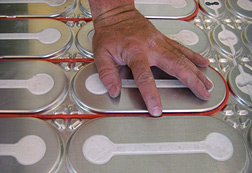
Installing heat cable in a floor heating insulation panel.
Of course there is the issue of maintenance and repairs. Hydronic systems circulate continuously, and rely on a system of valves and manifolds prone to sedimentation, mechanical problems and maintenance issues. If a hydronic heating system installation is faulty, it is difficult to find a leak, and because of the nature of the installation, even if the leak is found, it is difficult to repair. With electric radiant heat systems, fault detectors can pinpoint the exact location of a break. After breaking just one or two tiles, the electric cable can be spliced and the tiles replaced, a far better (and less costly) scenario than I’m imagining with our hydronic heated bathroom floor. Fortunately, Warmzone’s electric floor heating systems are built to last and feature the best warranty in the business. Generally, most homeowners opt for electric radiant heating. It’s well suited for small- to mid-sized home improvement projects. And the initial investment is modest enough that you won’t find yourself over your head, or under water when it’s time to tap into your home improvement budget.
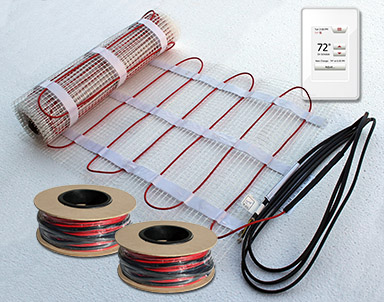
ComfortTile floor heating mat, cable and thermostat.
The floor heating mat features pre-spaced heat cable woven into a durable mat that simplifies the installation process.
Radiant Snow Melting for the Masses
We are nearing the end of another snow season, one that has been especially brutal in terms of snowfall, and it’s likely that most of us have grown tired of shoveling snow from our driveways. As you sit to rest your aching back, imagine a winter without having to shovel snow or throw down any deicing salt. Enter radiant heated driveways and snowmelt systems. Electric radiant snow melting systems are not just a fantasy anymore; they are the ticket to easy snow removal, and a much more pleasant winter.
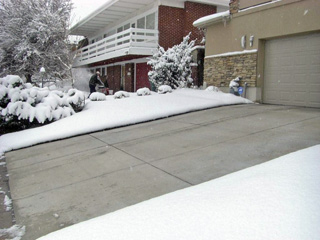
What used to be regarded as a luxury for exclusive upscale neighborhoods is now a reality for all of us. Given the custom options and affordability of radiant snow melting systems, heated driveways, steps and walkways have become increasingly popular among homeowners and businesses alike. Warmzone electric snow melting systems are fully automated, extremely durable and are built to last a lifetime.
The advancements in technology have translated into many benefits for consumers, including a wide range affordable installation options. Radiant snow melting systems can be installed in new and existing driveways, and in just about any type of custom configuration. Whether you want your whole driveway surface heated or just the tire tracks or other specific areas, Warmzone can design the ideal snow melting system for you.
Snow melting systems consist of a heat cable or wiring system installed within the surface of the driveway or sidewalk. When conditions for snow are present, a sensor will automatically signal the control unit which actives the system. The surface is heated and your driveway is now a “snow-free zone”. How much more convenient can it get than arriving at home on a snowy day to a nice clear driveway? No shoveling required!

